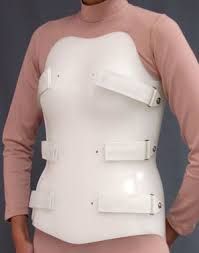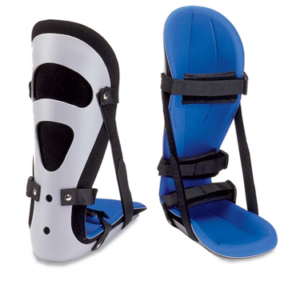What Is A TLSO And What Is It Used For?

The acronym TLSO is used to refer to thoraco-lumbo-sacral orthosis, which is a brace that provides support from mid to the lower portion of the spine. This brace is most commonly used to provide support and stabilization of the spine after a back injury and/or surgery.
There are a many different types of TLSOs, but the common styles are either Off the Shelf or Custom Fabricated. The decision of which type to use is up to the discretion of your medical provider and is often based off the severity of the injury, degree of control needed, and body shape/size.
Custom:
A custom brace is made of plastic with a soft foam liner for patient comfort. It can be made in one piece with a single opening in front or back but is more commonly made with two overlapping pieces that connect on the sides. This design is referred to as a clam-shell style. This brace is custom fabricated to either a mold or measurements of the patient’s body. The TLSO’s waist grooves must be placed low on the waist (the soft space on the side between the hipbone and ribs). Close the straps evenly and snugly (patient may need help). The orthotist can make marks on the side straps a guideline as to how tightly the TLSO should be fastened.
Off the Shelf:
An off the shelf is a prefabricated brace that is fit to your body based on your waist measurement which determines the size that will fit appropriately. The brace is then adjusted to match the patient’s size and shape in order to fit correctly.
Putting on the Brace:
• Putting a brace lying down (the safest way, but requires a helper)
• Move to one side of the bed by using your arms and legs to move your hips over or by having a helper pull the sheet under you over to one side.
• Roll to your side, away from the edge of the bed and onto your hip. Don’t twist your back, keep it straight by shifting your hips and shoulders at same time, rolling like a log.
• Have the person helping you position the back half of the brace on your back, making sure the waist indentations on the inside of the brace are just above your hip bones and below your ribs. The bottom edge of the brace should be near your tailbone.
• Have the person helping you hold the brace in place on your back while you log-roll flat onto your back.
• Position the front half of the brace, lining it up with the back half. Fully tighten all the straps, moving from the bottom to the top, making sure they are snug enough to provide support but still allow normal breathing.
• Secure any shoulder straps or under arm straps, these do not need to be pulled tight.
• Before getting up, make sure that the brace is aligned properly; adjust it, if necessary.
• Drop your legs over the side of the bed and push yourself up to a sitting position. Then slowly raise yourself to a standing position.
• Putting a brace on sitting up (easier, but can only be done with approval from your doctor)
• If you are sitting up while applying the TLSO, be sure to sit with your feet firmly on the floor.
• Align the back of the brace at the top of your tailbone and centered on your back
• Wrap the front panel around you keeping it in line with back panel
• Secure all Velcro straps starting at the bottom and working your way up, making sure they are snug enough to provide support but still allow normal breathing.
• Secure any shoulder straps or under arm straps, these do not need to be pulled tight.
• Check your brace to make sure it is fitting snugly, and that it is correctly aligned before you get up and move around.
Things to Remember:
When wearing the TLSO, it should be as TIGHT as possible/tolerable, with no gaps between the TLSO and the body or it will tend to “ride up”. If this is the case, lower the TLSO into the proper position and make it tighter than it was previously. Always wear a T-shirt under the brace to provide a barrier between the skin and the plastic and to absorb perspiration. If your brace has a chest piece (also known as the sternal shield), it should sit 2-3 fingers below the notch at the bottom of your neck to ensure proper positioning. These braces are specifically designed to protect and stabilize the spine. One should be able to sit in it and but will only be able to bend forward at the hips. The TLSO WILL NOT ALLOW A FORWARD SLOUCH of the head and shoulders. The front top portion of the TLSO will resist a forward slouch by becoming tight and uncomfortable on the chest and lower neck. If this occurs, sit as upright as possible. Inspections of the skin under the brace should be check daily for any breakdown. If any areas of breakdown or localized redness are noticed, please call the orthotic clinic to have the brace adjusted.




